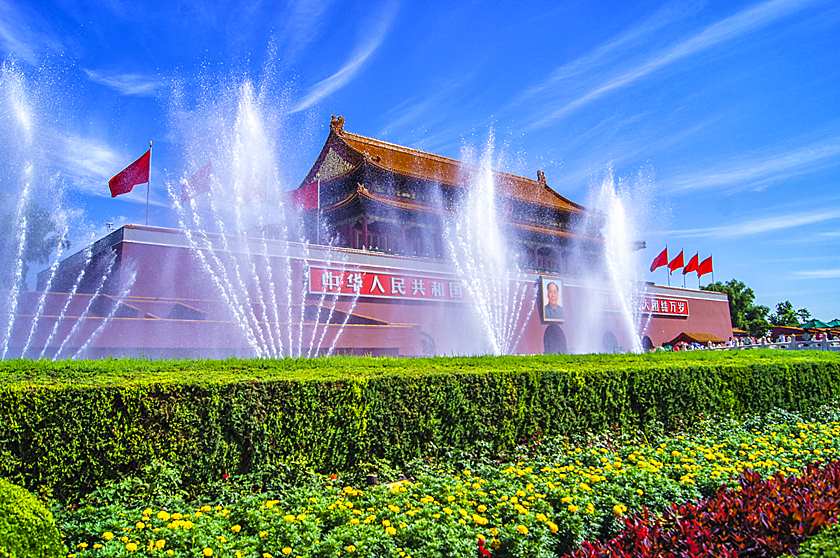Chinese Name: 天安门广场 Pronunciation: tiān ān mén guǎng chǎng
Building Time: 1417
Recommended Time for Visit: 1-2 Hours
Occupied Area: About 440,000 square meters
Address: East Changan St, Dongcheng District, Beijing.
Popular Activities: Raising and lowering the Chinese national flag.
Best Visiting Season: Spring and Autumn (March to May, September to November)
Building Function: An important place for the Ming and the Qing dynasties to hold major celebrations and issue decrees to the whole world and to show the majesty of the imperial power.
|
Tickets
|
Admission fee
|
| Tian’anmen Square | Free of charge |
| Tian’anmen Rostrum | 15 yuan |
| Great Hall of the People | 30 yuan |
| National Museum of China | Free of Charge |
|
Opening Hours
|
Peak Season
(April 1st to October 31st) |
Low Season
(November 1st to March 31st) |
| Tian’anmen Square | 5:00-22:00 | |
| Tian’anmen Rostrum | 8:30-17:00 | 8:30-16:30 |
| National Museum of China | 09:00-17:00 | |
| The Great Hall of the People | April 1st-June 30th | July 1st-August 31st | September 1st-November 31st | December 1st-March 31st |
| Opening Hours | 8:15-15:00 | 7:30-16:00 | 8:30-15:00 | 9:00-14:00 |
|
Attraction
|
Opening Hours
|
| Memorial Hall of Chairman Mao | Tuesday-Thursday: 8:00-12:00 for all year round |
| Except for July 1st-August 31st: 7:00-11:00 |
* The Great Hall of the People is closed to visitors during the National Two Sessions or other large-scale political events.
* The National Museum of China is closed every Monday
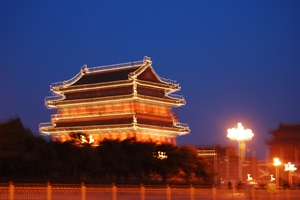
Tian’anmen Square is located in the center of Beijing City, covering an area of 440,000 square meters. With a capacity of one million people for public celebrations and gatherings, it is regarded as the largest city square in the world.
Tian’anmen Square starts from Tian’anmen Rostrum in the north, Zhengyang Gate in the south, the History Museum in the east and the Great Hall of the People in the west. There stands at the center of the square the Monument to the People’s Heroes and the solemn Memorial Hall of Chairman Mao. The whole square is magnificent and symmetrical, rated as the first of the 16 sights in Beijing.
Tian’anmen Square is of great historical and cultural significance. It was once a palace square outside the Forbidden City during the Ming and Qing dynasties. In modern times, no place in China that has such a loving connection with the people’s emotional world as Tian’anmen Square. Witnessing the occurrence of numerous historical events, it recorded the indomitable revolutionary spirit and fearless heroic spirit of the Chinese people.
As a sacred place for the People’s Republic of China to hold major celebrations and grand gatherings, Tian’anmen Square is also known as the center of Chinese political activities. It witnesses the decline and rise of China.
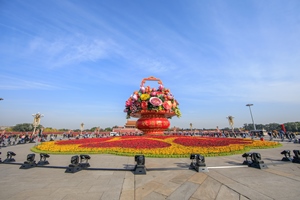
In 1417, the 15th year of the reign of Emperor of Yongle of the Ming Dynasty, Chengtianmen, the former name of Tian’anmen, was built.
In 1651, the 8th year of the reign of Emperor of Shunzhi of the Qing Dynasty, Tian’anmen Square was just a closed T-shaped palace square. It was an important place for the Ming and Qing dynasties to hold major celebrations and issue decrees to the whole country. It also represented the majesty of the imperial power.
In 1914, Tian’anmen Square was firstly renovated and became an open space for staying without the mystery and majesty of imperial power. It began to become a square in the modern sense.
In 1928, Sun Yat-sen’s portrait was hung on the Tian’anmen Rostrum, which was the first individual portrait hung on the tower.
On October 1st, 1949, the great founding ceremony of the People’s Republic of China was held in Tian’anmen Square.
In 1954, the Monument to the People’s Heroes was built at the center of Tian’anmen Square.
In 1958, to greet the 10th anniversary of the founding of the new China, Tian’anmen Square was expanded to the largest scale in history. At the same time, the Monument to the People’s Heroes and the Great Hall of the People set the tone of the square as a political center.

In 1976, the Memorial Hall of Chairman Mao was built, which was the last large-scale construction in Tian’anmen Square.
In 1988, Tian’anmen Rostrum was opened to the public.
On October 1st, 1999, the ceremony of the 50th anniversary of new China’s founding was held in the Tian’anmen Square.
On January 1st, 2018, the flag-raising ceremony, performed firstly by the honor guard and the military band of the Chinese People’s Liberation Army, was held in the Tian’anmen Square.
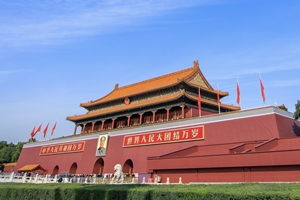
Tian’anmen Rostrum, located on the northern side of Tian’anmen Square, covers an area of 4,800 square meters. It is 34.7 meters high with red walls and yellow tiles on the roof. It is world-widely famous for its outstanding architecture and special political status.
Built-in 1417, the 15th year of the reign of Emperor Yongle in the Ming Dynasty, Tian’anmen is the main gate to the Forbidden city during the Ming and Qing dynasties. It was called Chengtianmen at that time, which meant that the emperor was appointed by heaven to govern the country and to bring peace to the country. It symbolizes the mystery and majesty of imperial power. Ordinary people were forbidden to pass through the Tian’anmen to the Forbidden City. Only the royal family can enter the rostrum.
In 1925, Tian’anmen Rostrum was open to the public. It was here that the great leader Chair Mao announced the founding of the People’s Republic of China to the world in 1949. Thus, it was designed as a part of the national emblem and became the national symbol of new China.
Several attractions draw thousands of visitors' view around the Tian’anmen Rostrum. In front of the rostrum is the Golden Water Bridge whose shape is like a rainbow with beautiful curves. In ancient times, it had strict hierarchical rules that people with different identities crossed the bridge in different ways. Besides, a pair of stone lions on the south and north side of the Golden Water Bridge are exquisitely carved, reflecting the carving technology of the Ming Dynasty.
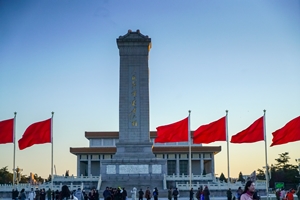
Located in the center of the Tian’anmen Square, the Monument to the People’s Heroes was built in 1958 with a height of 37.94 meters. It is the first building built on the square after the birth of the new China and is the largest monument in Chinese history.
The Monument to the People’s Heroes was erected to commemorate all the heroes and heroines who died in the struggles against internal and external enemies and for national independence since 1840. “The people’s heroes are immortal” can be read on the monument, which was written by Mao Zedong.

The Memorial Hall of Chairman Mao is the highest one in China, situated in the south of Tian’anmen Square. The body of Chairman Mao lies in the crystal coffins, surrounded by lots of flowers from people to show their great respect. The display of the memorial room, through a large number of photos, documents and real objects, presents the brilliant achievements of Chairman Mao and other leaders in various periods of China’s revolution and construction.
The Great Hall of the People is magnificent and lofty, which is mainly composed of three parts. The center hall is simple and elegant. Six main doors leading to the auditorium at the back, which can hold nearly 10,000 people. The grand banquet hall is located on the second floor with about 5,000 seats. Besides, there are various of halls with local characteristics named after each province.

Another attraction often mentioned by tourists is the National Museum of China located on the east side of Tian’anmen Square, which faces the Great Hall of the People. The National Museum of China, formerly known as the Chinese History Museum and Chinese Revolutionary Museum, is a famous collection of Chinese ancient, modern and contemporary precious historical and cultural relics.
The young museum came into existence in 2011. In 2018, the number of visitors to the National Museum of China reached 8.61 million, a record high, making it one of the most popular museums in the world. Here one can see the precious cultural relics of almost all dynasties in China. If you are interested in Chinese history and culture, this is a place you should not miss.

On the west side of Tian’anmen Square stands the Great Hall of the People, erected in 1959 with an area of about 170,000 square meters. It is the place where the Chinese National People’s Congress and other large national gatherings are held, as well as the place for political activities and diplomatic affairs. It was opened to the public in 1979. As the largest auditorium in the world, the Great Hall of the People was included in the first Chinese 20th-century architectural heritage list in 2016.
The Great Hall of the People is magnificent and lofty, which is mainly composed of three parts. The center hall is simple and elegant. Six main doors leading to the auditorium at the back, which can hold nearly 10,000 people. The grand banquet hall is located on the second floor with about 5,000 seats. Besides, there are various halls with local characteristics named after each province.
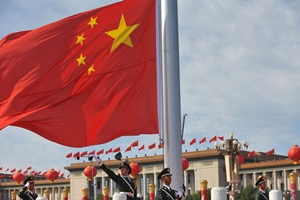
Five Star Red Flag, the Chinese national flag, is raised over Tian’anmen Square every morning, almost at the same time as the sunrise. If one wants to get a good view of the whole ceremony, one has to arrive at the square before sunrise. Since the first day of 2012, the reviewing stands on the east and west sides of Tian’anmen Rostrum had been opened to the public for free.
The place that everyone who comes to Beijing cannot miss the most is Tian’anmen Square and the activity that cannot miss the most is to watch the flag-raising. Every year thousands of visitors, both at home and aboard, flock to the square to see the spectacular sight of the guard of honor to raise the Chinese national flag. It will be the most memorable part of one’s trip.
a. T’anmen Rostrum→North Gate of the Square→Monument to the People’s Heroes→Memorial Hall of Chairman Mao→Exit from the Front Gate.
b. T’anmen Rostrum→North Gate of the Square→Monument to the People’s Heroes→Memorial Hall of Chairman Mao→Exit from the East Gate→National Museum of China.
c. National Museum of China→East Gate of the Square →Monument to the People’s Heroes →Memorial Hall of Chairman Mao→Exit from the West Gate→Great Hall of the People→Tian’anmen Rostrum.
d. Enter from Front Gate of the Square→Memorial Hall of Chairman Mao→Monument to the People’s Heroes→Exit from the West Gate→Great Hall of the People→Tian’anmen Rostrum.
East Gate: Take bus 2, 5, 120, Sightseeing Bus Line 2 and get off at the Tian’anmen Guangchang Dong Station (Tian’anmen Square East).
West Gate: Take bus 2, 120, Sightseeing Bus Line 2 and get off at the Tian’anmen Guangchang Xi Station (Tian’anmen Square West).
Zhengyang Gate (South Gate): ①Take bus 2, 5, 8, 20, 22, 48, 59, 66, 67, 82 and get off at the Qianmen Station (Zhengyang Gate).
Take Subway Line 1 and get off at the Tian’anmen Dong or Tian’anmen Xi Station.
Take Subway Line 2, get off at the Qianmen Station and walk north to the square.
Chinese: 请带我去天安门。English: Please take me to Tian’anmen Square.
Chinese: 请带我去天安门广场。English: Please take me to the Tian’anmen Square.
Chinese: 请带我去天安门广场的东门。English: Please take me to the East Gate of Tian’anmen Square.
Chinese: 请带我去天安门广场的西门。English: Please take me to the West Gate of Tian’anmen Square.
Chinese: 请带我去天安门广场的北门。English: Please take me to the North Gate of Tian’anmen Square.
Chinese: 请带我去天安门广场的前门(南门)。English:Please take me to the Front Gate (South Gate) of Tian’anmen Square.
If you go to the Tian’anmen Square from Beijing Capital International Airport, it takes about 50 minutes (100 yuan).
If you go to the Tian’anmen Square from the Beijing Daxing International Airport, it takes about 70 minutes (180 yuan).
If you go to the Tian’anmen Square from the Beijing East Train Station, it takes about 35 minutes (30 yuan).
If you go to the Tian’anmen Square from the Beijing West Train Station, it takes about 20 minutes (25 yuan).
If you go to the Tian’anmen Square from the Beijing South Train Station, it takes about 20 minutes (25 yuan).
If you go to the Tian’anmen Square from the Beijing North Train Station, it takes about 30 minutes (30 yuan).
